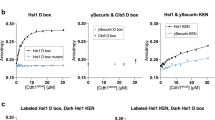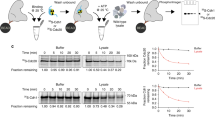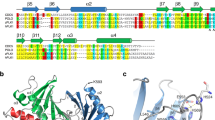Abstract
The ubiquitylation of cell-cycle regulatory proteins by the large multimeric anaphase-promoting complex (APC/C) controls sister chromatid segregation and the exit from mitosis1,2. Selection of APC/C targets is achieved through recognition of destruction motifs, predominantly the destruction (D)-box3 and KEN (Lys-Glu-Asn)-box4. Although this process is known to involve a co-activator protein (either Cdc20 or Cdh1) together with core APC/C subunits1,2, the structural basis for substrate recognition and ubiquitylation is not understood. Here we investigate budding yeast APC/C using single-particle electron microscopy and determine a cryo-electron microscopy map of APC/C in complex with the Cdh1 co-activator protein (APC/CCdh1) bound to a D-box peptide at ∼10 Å resolution. We find that a combined catalytic and substrate-recognition module is located within the central cavity of the APC/C assembled from Cdh1, Apc10—a core APC/C subunit previously implicated in substrate recognition5,6,7—and the cullin domain of Apc2. Cdh1 and Apc10, identified from difference maps, create a co-receptor for the D-box following repositioning of Cdh1 towards Apc10. Using NMR spectroscopy we demonstrate specific D-box–Apc10 interactions, consistent with a role for Apc10 in directly contributing towards D-box recognition by the APC/CCdh1 complex. Our results rationalize the contribution of both co-activator and core APC/C subunits to D-box recognition8,9 and provide a structural framework for understanding mechanisms of substrate recognition and catalysis by the APC/C.
This is a preview of subscription content, access via your institution
Access options
Subscribe to this journal
Receive 51 print issues and online access
$199.00 per year
only $3.90 per issue
Buy this article
- Purchase on Springer Link
- Instant access to full article PDF
Prices may be subject to local taxes which are calculated during checkout




Similar content being viewed by others
Accession codes
References
Peters, J. M. The anaphase promoting complex/cyclosome: a machine designed to destroy. Nature Rev. Mol. Cell Biol. 7, 644–656 (2006)
Thornton, B. R. & Toczyski, D. P. Precise destruction: an emerging picture of the APC. Genes Dev. 20, 3069–3078 (2006)
Glotzer, M., Murray, A. W. & Kirschner, M. W. Cyclin is degraded by the ubiquitin pathway. Nature 349, 132–138 (1991)
Pfleger, C. M. & Kirschner, M. W. The KEN box: an APC recognition signal distinct from the D box targeted by Cdh1. Genes Dev. 14, 655–665 (2000)
Carroll, C. W. & Morgan, D. O. The Doc1 subunit is a processivity factor for the anaphase-promoting complex. Nature Cell Biol. 4, 880–887 (2002)
Passmore, L. A. et al. Doc1 mediates the activity of the anaphase-promoting complex by contributing to substrate recognition. EMBO J. 22, 786–796 (2003)
Carroll, C. W., Enquist-Newman, M. & Morgan, D. O. The APC subunit Doc1 promotes recognition of the substrate destruction box. Curr. Biol. 15, 11–18 (2005)
Yamano, H., Gannon, J., Mahbubani, H. & Hunt, T. Cell cycle-regulated recognition of the destruction box of cyclin B by the APC/C in Xenopus egg extracts. Mol. Cell 13, 137–147 (2004)
Eytan, E., Moshe, Y., Braunstein, I. & Hershko, A. Roles of the anaphase-promoting complex/cyclosome and of its activator Cdc20 in functional substrate binding. Proc. Natl Acad. Sci. USA 103, 2081–2086 (2006)
Vodermaier, H. C., Gieffers, C., Maurer-Stroh, S., Eisenhaber, F. & Peters, J. M. TPR subunits of the anaphase-promoting complex mediate binding to the activator protein CDH1. Curr. Biol. 13, 1459–1468 (2003)
Kraft, C., Vodermaier, H. C., Maurer-Stroh, S., Eisenhaber, F. & Peters, J. M. The WD40 propeller domain of Cdh1 functions as a destruction box receptor for APC/C substrates. Mol. Cell 18, 543–553 (2005)
Thornton, B. R. et al. An architectural map of the anaphase-promoting complex. Genes Dev. 20, 449–460 (2006)
Wendt, K. S. et al. Crystal structure of the APC10/DOC1 subunit of the human anaphase-promoting complex. Nature Struct. Biol. 8, 784–788 (2001)
Burton, J. L. & Solomon, M. J. D box and KEN box motifs in budding yeast Hsl1p are required for APC-mediated degradation and direct binding to Cdc20p and Cdh1p. Genes Dev. 15, 2381–2395 (2001)
Hilioti, Z., Chung, Y. S., Mochizuki, Y., Hardy, C. F. & Cohen-Fix, O. The anaphase inhibitor Pds1 binds to the APC/C-associated protein Cdc20 in a destruction box-dependent manner. Curr. Biol. 11, 1347–1352 (2001)
Pfleger, C. M., Lee, E. & Kirschner, M. W. Substrate recognition by the Cdc20 and Cdh1 components of the anaphase-promoting complex. Genes Dev. 15, 2396–2407 (2001)
Schwab, M., Neutzner, M., Mocker, D. & Seufert, W. Yeast Hct1 recognizes the mitotic cyclin Clb2 and other substrates of the ubiquitin ligase APC. EMBO J. 20, 5165–5175 (2001)
Passmore, L. A. et al. Structural analysis of the anaphase-promoting complex reveals multiple active sites and insights into polyubiquitylation. Mol. Cell 20, 855–866 (2005)
Dube, P. et al. Localization of the coactivator Cdh1 and the cullin subunit Apc2 in a cryo-electron microscopy model of vertebrate APC/C. Mol. Cell 20, 867–879 (2005)
Ohi, M. D. et al. Structural organization of the anaphase-promoting complex bound to the mitotic activator Slp1. Mol. Cell 28, 871–885 (2007)
Herzog, F. et al. Structure of the anaphase-promoting complex/cyclosome interacting with a mitotic checkpoint complex. Science 323, 1477–1481 (2009)
Au, S. W., Leng, X., Harper, J. W. & Barford, D. Implications for the ubiquitination reaction of the anaphase-promoting complex from the crystal structure of the Doc1/Apc10 subunit. J. Mol. Biol. 316, 955–968 (2002)
Matyskiela, M. E. & Morgan, D. O. Analysis of activator-binding sites on the APC/C supports a cooperative substrate-binding mechanism. Mol. Cell 34, 68–80 (2009)
Yamano, H., Tsurumi, C., Gannon, J. & Hunt, T. The role of the destruction box and its neighbouring lysine residues in cyclin B for anaphase ubiquitin-dependent proteolysis in fission yeast: defining the D-box receptor. EMBO J. 17, 5670–5678 (1998)
Zheng, N. et al. Structure of the Cul1–Rbx1–Skp1–F boxSkp2 SCF ubiquitin ligase complex. Nature 416, 703–709 (2002)
Zhang, Z. et al. Molecular structure of the N-terminal domain of the APC/C subunit Cdc27 reveals a homo-dimeric tetratricopeptide repeat architecture. J. Mol. Biol. 397, 1316–1328 (2010)
van Heel, M. et al. Single-particle electron cryo-microscopy: towards atomic resolution. Q. Rev. Biophys. 33, 307–369 (2000)
Frank, J. et al. SPIDER and WEB: processing and visualization of images in 3D electron microscopy and related fields. J. Struct. Biol. 116, 190–199 (1996)
Ludtke, S. J., Baldwin, P. R. & Chiu, W. EMAN: semiautomated software for high-resolution single-particle reconstructions. J. Struct. Biol. 128, 82–97 (1999)
Passmore, L. A., Barford, D. & Harper, J. W. Purification and assay of the budding yeast anaphase-promoting complex. Methods Enzymol. 398, 195–219 (2005)
Kelley, L. A. & Sternberg, M. J. Protein structure prediction on the web: a case study using the Phyre server. Nature Protocols 4, 363–371 (2009)
Schuetz, A. et al. Structural basis for molecular recognition and presentation of histone H3 by WDR5. EMBO J. 25, 4245–4252 (2006)
Angers, S. et al. Molecular architecture and assembly of the DDB1–CUL4A ubiquitin ligase machinery. Nature 443, 590–593 (2006)
Navaza, J., Lepault, J., Rey, F. A., Alvarez-Rua, C. & Borge, J. On the fitting of model electron densities into EM reconstructions: a reciprocal-space formulation. Acta Crystallogr. D Biol. Crystallogr. 58, 1820–1825 (2002)
Baryshnikova, O. K., Williams, T. C. & Sykes, B. D. Internal pH indicators for biomolecular NMR. J. Biomol. NMR 41, 5–7 (2008)
Delaglio, F. et al. NMRPipe: a multidimensional spectral processing system based on UNIX pipes. J. Biomol. NMR 6, 277–293 (1995)
Vranken, W. F. et al. The CCPN data model for NMR spectroscopy: development of a software pipeline. Proteins 59, 687–696 (2005)
Wu, D., Chen, A. & Johnson, C. S., Jr An improved diffusion-ordered spectroscopy experiment incorporating bipolar-gradient pulses. J. Magn. Reson. A 115, 260–264 (1995)
Acknowledgements
This work was funded by a Cancer Research UK grant to D.B. We thank F. Beuron for help with the early stages of this project and for EM support. We are grateful to J. Kirkpatrick for the use of the facilities of the UCL/Birkbeck Institute of Structural Molecular Biology (ISMB) Biomolecular NMR Centre.
Author information
Authors and Affiliations
Contributions
All authors contributed to experimental design, data analysis and manuscript preparation. P.C.A.d.F. and E.H.K. collected and analysed EM data, E.H.K. prepared APC/C samples and performed ubiquitylation assays. P.C.A.d.F. determined the three-dimensional EM reconstructions and fitted coordinates. M.A.W. performed NMR experiments and analysed NMR data. E.P.M. helped collect and analyse EM data.
Corresponding author
Ethics declarations
Competing interests
The authors declare no competing financial interests.
Supplementary information
Supplementary Information
The file contains Supplementary Figures 1-12 with legends, Supplementary Tables 1-2 and additional references. (PDF 27933 kb)
Supplementary Movie 1
The movie shows morphing between APC/CCdh1 binary complex and APC/CCdh1•D-box ternary complex illustrating repositioning of Cdh1 (magenta) towards Apc10 (blue). Both complexes used are negative stain reconstructions. (AVI 6803 kb)
Rights and permissions
About this article
Cite this article
da Fonseca, P., Kong, E., Zhang, Z. et al. Structures of APC/CCdh1 with substrates identify Cdh1 and Apc10 as the D-box co-receptor. Nature 470, 274–278 (2011). https://doi.org/10.1038/nature09625
Received:
Accepted:
Published:
Issue Date:
DOI: https://doi.org/10.1038/nature09625
This article is cited by
-
The ZZ domain of HERC2 is a receptor of arginylated substrates
Scientific Reports (2022)
-
Single-molecule analysis of specificity and multivalency in binding of short linear substrate motifs to the APC/C
Nature Communications (2022)
-
The scaffold protein IQGAP1 links heat-induced stress signals to alternative splicing regulation in gastric cancer cells
Oncogene (2021)
-
Ubiquitin chain-elongating enzyme UBE2S activates the RING E3 ligase APC/C for substrate priming
Nature Structural & Molecular Biology (2020)
-
Interplay between c-Src and the APC/C co-activator Cdh1 regulates mammary tumorigenesis
Nature Communications (2019)
Comments
By submitting a comment you agree to abide by our Terms and Community Guidelines. If you find something abusive or that does not comply with our terms or guidelines please flag it as inappropriate.



